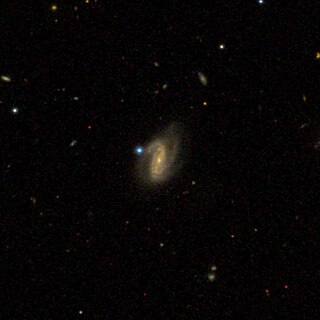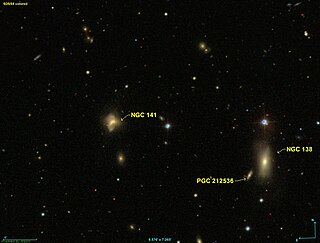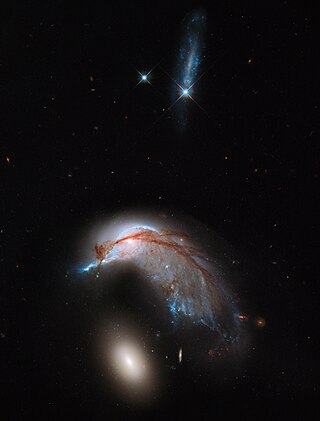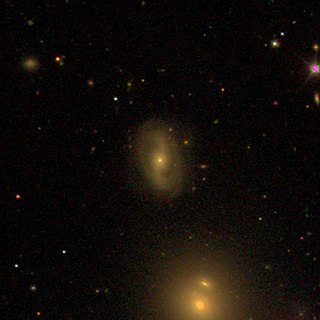Related Research Articles

NGC 3 is a lenticular galaxy with the morphological type of S0, located in the constellation of Pisces. Other sources classify NGC 3 as a barred spiral galaxy as a type of SBa. It was discovered on November 29, 1864, by Albert Marth.

The Atlas of Peculiar Galaxies is a catalog of peculiar galaxies produced by Halton Arp in 1966. A total of 338 galaxies are presented in the atlas, which was originally published in 1966 by the California Institute of Technology. The primary goal of the catalog was to present photographs of examples of the different kinds of peculiar structures found among galaxies.

UGC 9796 is a lenticular and polar-ring galaxy in the constellation Boötes, and about 250 million light years distant from Earth. It is an object of great scientific interest as there have been very few polar ring galaxies discovered. UGC 9796 is a very gas-rich environment hosting as much 5×109 solar masses of neutral hydrogen. DSS and SDSS images show that it is very similar to polar ring galaxy NGC 660, the best-known of all the polar ring galaxies.

NGC 139 is a barred spiral galaxy in the constellation Pisces. It was discovered on August 29, 1864, by the German astronomer Albert Marth.

NGC 141 is a lenticular galaxy in the constellation of Pisces. Discovered by Albert Marth on August 29, 1864, it is about 525 million light-years away and is approximately 100,000 light-years across.

NGC 325 is a spiral galaxy located in the constellation Cetus. It was discovered on September 27, 1864 by Albert Marth. It was described by Dreyer as "very faint, very small".

NGC 359 is an elliptical galaxy located approximately 238 million light-years from the Solar System in the constellation Cetus. It was discovered on September 2, 1864, by Albert Marth. It was described by Dreyer as "extremely faint, very small."

NGC 364 is a barred lenticular galaxy in the constellation Cetus. It was discovered on September 2, 1864, by Albert Marth. It was described by Dreyer as "very faint, very small."

NGC 5050 is a lenticular galaxy in the constellation Virgo. It was discovered by a German astronomer Albert Marth on April 30, 1864. It is also known as CGCG 44-43, MCG 1-34-12, PGC 46138, UGC 8329.

NGC 471 is a lenticular galaxy located about 168 million light-years away from Earth in the constellation Pisces. It was discovered by the German astronomer Albert Marth on November 3, 1864.

NGC 479 is a spiral galaxy in the constellation Pisces. It was discovered by German astronomer Albert Marth on October 27, 1864. It is about 240 million light-years away from Earth.

NGC 511, also occasionally referred to as PGC 5103 or UGC 936, is an elliptical galaxy in the constellation Pisces. It is located approximately 499 million light-years from the Solar System and was discovered on 26 October 1876 by French astronomer Édouard Stephan.

NGC 515, also occasionally referred to as PGC 5201 or UGC 956, is a lenticular galaxy located approximately 228 million light-years from the Solar System in the constellation Pisces. It was discovered on 13 September 1784 by astronomer William Herschel.

NGC 521, also occasionally referred to as PGC 5190 or UGC 962, is a barred spiral galaxy located approximately 224 million light-years from the Solar System in the constellation Cetus. It was discovered on 8 October 1785 by astronomer William Herschel.

NGC 522, also occasionally referred to as PGC 5218 or UGC 970, is a spiral galaxy located approximately 122 million light-years from the Solar System in the constellation Pisces. It was discovered on 25 September 1862 by astronomer Heinrich Louis d'Arrest.

NGC 2936, also known as the Penguin Galaxy or the Porpoise Galaxy, is an interacting spiral galaxy located at a distance of 326 million light years, in the constellation Hydra. NGC 2936 is interacting with elliptical galaxy NGC 2937, located just beneath it. They were both discovered by Albert Marth on Mar 3, 1864. To some astronomers, the galaxy looks like a penguin or a porpoise. NGC 2936, NGC 2937, and PGC 1237172 are included in the Atlas of Peculiar Galaxies as Arp 142 in the category "Galaxy triplet".

NGC 765 is an intermediate spiral galaxy located in the constellation Aries. It is located at a distance of circa 220 million light years from Earth, which, given its apparent dimensions, means that NGC 765 is about 195,000 light years across. It was discovered by Albert Marth on October 8, 1864. The galaxy has an extensive hydrogen (HI) disk with low surface brightness, whose diameter is estimated to be 240 kpc.

NGC 4056 is an elliptical galaxy located about 340 million light-years away in the constellation Coma Berenices. The galaxy was discovered by astronomer Albert Marth on March 18, 1865 and is a member of the NGC 4065 Group.

NGC 998 is a spiral galaxy in the constellation Cetus. It is estimated to be 294 million light years from the Milky Way and has a diameter of approximately 90,000 ly. Together with NGC 997, it forms a gravitationally bound pair of galaxies. NGC 998 was discovered by astronomer Albert Marth on 10 November 1863 using a 48-inch telescope.
References
- 1 2 3 4 5 6 7 8 "NED results for object NGC 6975". NASA/IPAC Extragalactic Database. National Aeronautics and Space Administration / Infrared Processing and Analysis Center . Retrieved 27 May 2018.
- 1 2 "UGC 11676". SIMBAD . Centre de données astronomiques de Strasbourg . Retrieved 29 May 2018.
- ↑ Seligman, Courtney. "New General Catalogue objects: NGC 7000 - 7049". cseligman.com. Retrieved 29 May 2018.
- 1 2 3 4 5 6 Corwin, Harold. "Notes on the NGC objects, particularly those missing, misidentified, or otherwise unusual (ngcnotes.all)". Historically-aware NGC/IC Positions and Notes. Retrieved 29 May 2018.